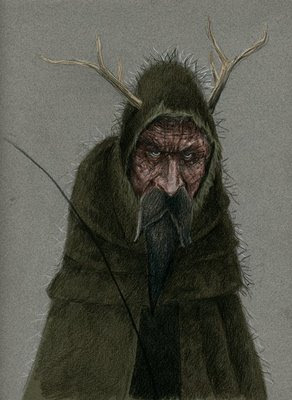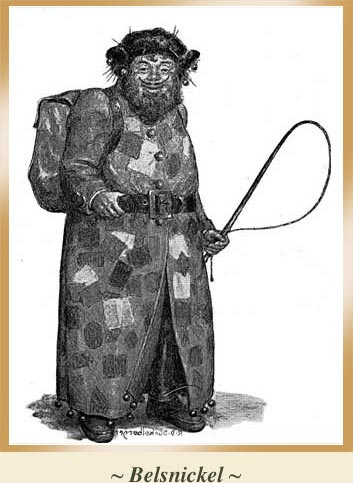Today at Christmas, we have Santa Claus, the jolly old elf who brings joy to children, and asks only milk and cookies in return.
In other traditions, the English had St. Nicholas and the Dutch had Sinterklaas. But what did the Palatine children of the Hudson Valley believe in during the 18th and 19th century?
The answer in a word, Belsnickel. The answer in a photo:

Rather than a jolly old elf, Belsnickel is a crotchety old man dressed in dirty clothes and furs, usually with his face disguised, who was both gift bringer and child punisher in the Palatine region of southwestern Germany.
There are several variations of the spelling including Pelznickel, which would seem the most likely as “Pelz” in German means fur and Nickel is related to Nicholas. Sometimes, his fur hat has deer antlers which allude to a pagan origin of the character.
In New York State, Palatine immigrants initially settled in the Hudson Valley, bringing the legend of Belsnickel with them.
In 1710, the largest eighteenth century migrations of Europeans to America took place when three hundred families from the Palatine region sailed 110 miles north up the Hudson from Manhattan. There, they established camps on both sides of the river, with the West Camp later becoming the Town of Saugerties and the East Camp becoming Germantown.
Later in the 18th century, Palatine families also spread into the Mohawk Valley and founded such communities as Herkimer, Palatine Bridge and German Flats.
Belsnickel is different from other variations of Christmas characters in that he combines both threatening and generous aspects of a Christmas spirit.

The basic tradition is thus; sometime between St. Nicholas Day and Christmas Eve, Palatine children would hear a tapping at their window at night and suddenly Belsnickel would burst through the door. He would be carrying a sack of presents and a switch. (Belsnickel was the first of the Christmas characters to distinguish between good and bad children. And unlike Santa Claus, who is never to be seen by children, Belsnickel and his message are meant to be seen and heeded…)
The children of the house would be lined up and asked if they were good that year. In some cases they would be asked to recite something from school or a passage from the Bible. If they succeeded they got a present from the sack. If they lied about being good or couldn’t do their recitation, they got a whack from the switch. In some versions of the tale, Belsnickel might merely leave the switch in the stockings of naughty children, similar to the practice by Santa Claus of leaving coal for those who had misbehaved.

In another variation, Belsnickel would scatter treats or gifts on the floor during his visit. If the children waited for permission, they could have the presents. If they dove in greedily without waiting, then Belsnickel walloped them all with his switch.
It has been difficult to find traces of Belsnickel in the Hudson Valley but his legend has lived on, particularly in the Pennsylvania Dutch, whose roots are actually Palatine German, not Dutch. Perhaps in the Hudson Valley, the Dutch and English influence drove him out earlier.
Belsnickel all but disappeared in the first half of the 20th century thanks to two world wars where Germany and all things German were the enemy. Suddenly many people of Deutsche (German in that language) descent became Dutch and many German traditions were quietly swept under the rug.
However, Belsnickel has seen a bit of a resurgence in recent years. He now features in several holiday festivals in Pennsylvania and even appeared in a holiday episode of “The Office” a few years ago.

So perhaps this year as children in the Hudson Valley prepare for the arrival of Santa Claus, they should listen carefully for a tapping on their window. It just may be Belsnickel checking to see if they have been naughty or nice!
Happy Holidays, Merry Christmas, Fröhliche Weihnachten and to all a good night!
Post by Geoff Benton, Curator of Education and Collections, Clermont State Historic Site.
Check out the Clermont blog for interesting historical items on the history of the Hudson Valley and the former home of New York’s politically and socially prominent Livingston Family. Seven successive generations of the family left their imprint on the site’s architecture, room interiors and landscape. Robert R. Livingston, Jr. was Clermont’s most notable resident. His accomplishments include: drafting the Declaration of Independence, serving as first U.S. Minister of Foreign Affairs, administering the oath of office to George Washington, negotiating the Louisiana Purchase and developing steamboat technology with Robert Fulton.
Read these contemporary accounts of the Belsnickel legend in the Pittsburgh Post-Gazette and the Allentown Morning Call.
Find another version of the tale in the Indiana German Heritage Society newsletter.

